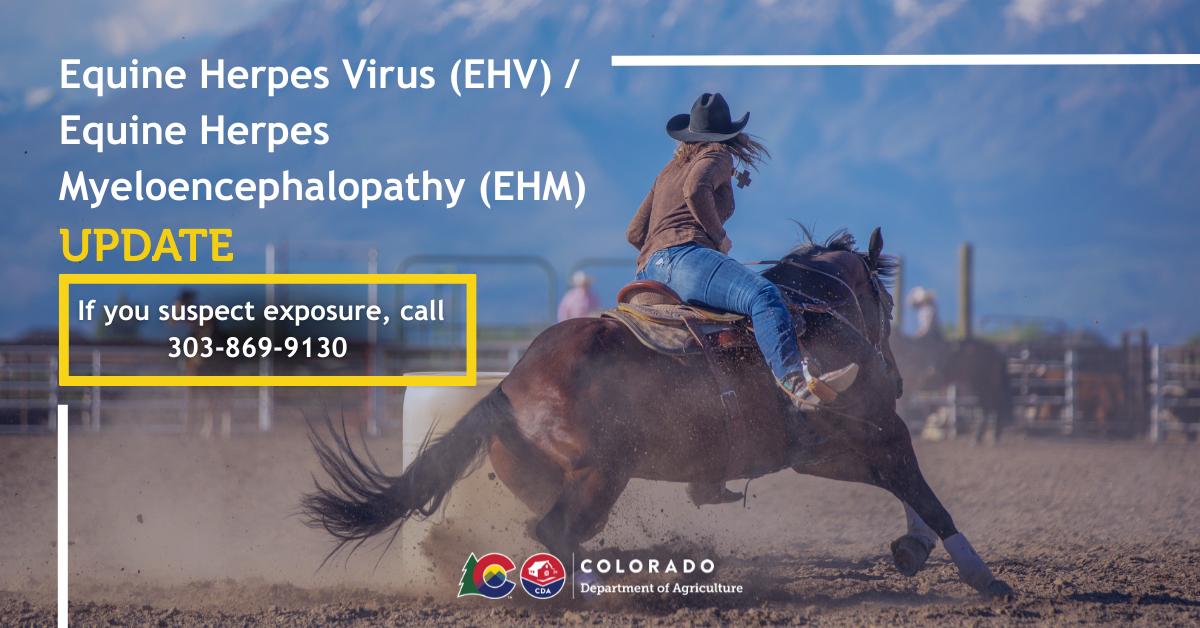Equine Herpes Virus Outbreak
Equine Herpes Myeloencephalopathy (EHM)
Equine Herpes Myeloencephalopathy (EHM) is a neurological disease of horses caused by equine herpes virus (EHV).
Equine herpesvirus is a common DNA virus that occurs in horse populations worldwide. The two most common strains are EHV-1, which causes abortion, respiratory disease and neurological disease; and EHV-4, which usually causes respiratory disease only but can occasionally cause abortion and rarely cause neurological disease. EHM is very contagious and can have a mortality rate as high as 30%.
Colorado has not probibited movement of horses in the state. Movement restrictions apply only to horses exposed to EHV and those showing symptoms.
Resources for Veterinarians
- The Merck Veterinary Manual: Equine Herpesvirus Infection
- Colorado State University (CSU) paper on EHM
- Awakening the Dormant Dragon: Neurological Form of EHV-1
Resources for Horse Owners
Equine Herpes Virus Information
EHV‐1 is a highly contagious and sometimes fatal virus that is spread from horse to horse through contact with nasal discharge or spread as aerosol droplets. Infected horses may not show clinical signs of the virus but may still act as carriers.
Horses can also contract the virus by coming into contact with contaminated surfaces such as stalls, water, feed, tack, and transport vehicles. People can spread the virus from horse to horse by contaminated hands and clothing.
It is important for owners to watch for signs and symptoms and practice biosecurity measures. Good biosecurity practices include extensive cleaning and disinfection of surfaces and equipment that come in contact with affected horses, and individuals who treat or come into contact with infected horses need to follow appropriate disinfection protocols when handling multiple horses.

Confirmed EHV-1 Cases in Colorado
Guidance for Horse Owners
If your horses traveled to Texas and Oklahoma where EHV exposure may have occurred, please contact the State Veterinarian’s Office. The following guidance for isolation and monitoring should be implemented:
- Exposed horses should be isolated for 21 days after the last known exposure.
- Appropriate isolation includes restricted access to other horses and avoiding the sharing of equipment or personnel.
- Monitor horses twice daily for:
- Elevated temperature (above 101.5°F).
- Respiratory signs (nasal discharge, coughing).
- Clinical signs consistent with EHM (neurologic symptoms including inability to stand, difficulty walking, lethargy, and urine dribbling).
- Maintain a log of temperatures and clinical signs.
Contact your private veterinarian immediately if elevated temperature, respiratory signs, or EHM-compatible clinical signs are noticed.
Guidance for Veterinarians
Reporting: If you have a horse with signs of acute neurologic disease, please contact the State Veterinarian’s Office at 303-869-9130. After-hours calls will be directed to the veterinarian on call.
Testing: Guidance on isolation and testing will be provided. Diagnosis can be difficult due to varying viral shedding. Paired samples, including nasal swab and whole blood, are critical for accurate diagnosis.
Interstate Movement
Many states may be implementing movement restrictions or new import requirements for equines during this outbreak. Always always check with the state of destination to ensure that you are following the most current import requirements.
Due to the equine herpes outbreak associated with barrel racing and rodeo-type events in Texas and Oklahoma, all equine CVIs for horses entering Colorado will require the following statement: “The equines listed on this CVI have not originated from a premises currently quarantined for EHV-1, have not been exposed to EHV-1, and have not attended an event where EHV-1 has been confirmed.”
Guidance for Upcoming Equine Events
Equine herpes virus can be shed for prolonged periods of time, including in clinically healthy horses, which increases risk for continued disease spread. Biosecurity is critical, as EHV is a common virus present in the environment.
Event Organizers
- Consult with a veterinarian to understand the risks associated with hosting events during a multi-state outbreak.
- Consider cancellation or postponement to prevent continued spread.
- If events proceed, strongly recommend short-timed health certificates (within 72 hours) and increasing on-site biosecurity practices, such as:
- Limiting horse-to-horse contact (e.g., maintaining 30 feet between tied horses).
- Avoiding shared water tanks, buckets, tack, or grooming supplies.
- Establishing a disinfectant protocol for stabling areas.
- Sending sick horses home immediately and having a plan for an isolation pen.
Horse Owners Attending Events
- Consult with your private veterinarian on the risks associated with travel to upcoming events.
- Strictly implement biosecurity measures before, during, and after the event